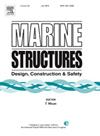Glass fiber reinforced polymer (GFRP) has been applied in hull structures for small and medium-size ships due its lightweight, high strength and easy fabrication. When the action load coming from the ship self-weight and the ocean environment becomes extremely large, the GFRP hull structure may present special failure modes and their evolution processes. How to define the ultimate strength study for GFRP hulls is a critical issue for vessel safety design. In this paper, one GFRP girder to represent the structural properties of the actual hull structure is selected as the research object. The GFRP girder is made of plates of varying thickness strengthened by hat stiffeners and foam. The hat stiffener, its attaching plate and core foam are made using an integral vacuum forming technique to avoid local construction defects. The sectional corners of the GFRP girder are provided with sufficient support by a combination of adhesive bonding and bolt secure connections. The failure experiment for the GFRP girder is performed on a four-point bending facility with a single hydraulic actuator to apply the bending moment. The strain variation is recorded by the digital image correlation (DIC) system on deck upper surface and 42 strain gauges on other critical regions. The deformation data is measured by 11 displacement sensors during a step-like increase of the applied load. The deformed shape are also recorded by the DIC system and the camera. Based on the experimental results, curves of the applied load and structural displacement are plotted to obtain the ultimate strength of the experiment girder. The failure modes and their evaluation processes are also discussed based on the video recordings. Finally, the failure process of the experiment GFRP girder is simulated using the nonlinear finite element method to study the effect of local delamination at various locations where the ultimate strength is determined. Both the experimental results and direct calculations demonstrate that the GFRP girder may exhibit a kind of brittle failure after the limit load point. The conclusions obtained in this paper will provide a guide for the design of GFRP ships and the modification of ship rules.


